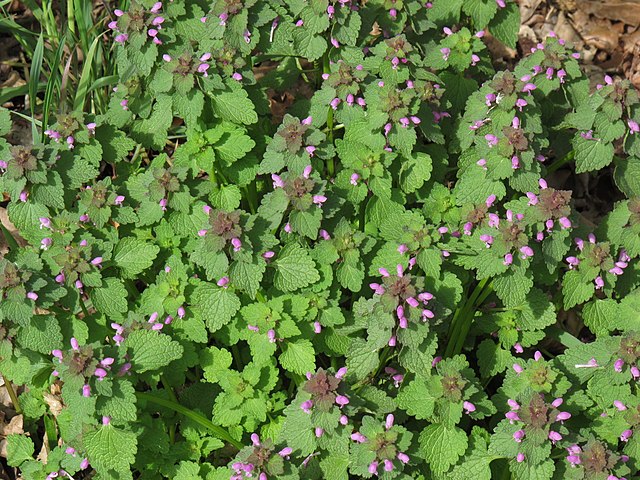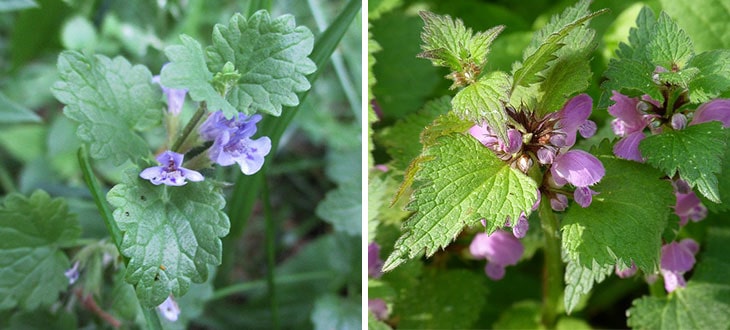3 Creeping Charlie Look-Alikes
Are you looking to identify creeping Charlie and want to know if there are similar plants you can mistaken it with? Here are 3 creeping Charlie look-alikes.
Creeping Charlie (Glechoma hederacea), also known under names like ground-ivy, alehoof, catsfoot, field balm, or run-away-robin, is a perennial, evergreen plant in the mint family, Lamiaceae.
Glechoma hederacea is native to Eurasia and was introduced to North America and other parts of the world as a medicinal or ornamental plant, used occasionally as a groundcover.
The young leaves of creeping Charlie are edible and are often consumed in salads or cooked. However, they may be potentially toxic to livestock, particularly horses, due to their high concentrations of volatile oils.
Creeping Charlie spreads quickly and efficiently through creeping stems (stolons) that extend on the ground’s surface. It can also multiply via rhizomes and seeds.
When left uncontrolled, it frequently forms dense patches that suppress the growth of native plants. Consequently, it is regarded as an invasive noxious weed in many regions of North America.
Glechoma hederacea is a weed that can withstand mowing, and it is regularly found growing in lawns. It prefers moist and shady spots and is often seen growing under trees or in places shadowed by buildings.
Although creeping Charlie is a fairly easy-to-identify weed, there are still a few plants with similar appearance and characteristics.
How To Identify Creeping Charlie
Before diving into the particularities of this plant, creeping Charlie may also be recognized by its growth habit.
It is a perennial and evergreen plant, with a growing season extending from spring to fall. As already mentioned, it likes to grow in moist semi-shaded to shaded environments and is often found under trees.
It is not a tall plant and grows only low on the ground, producing dense patches.
Creeping Charlie has kidney-shaped to rounded bright green leaves with scalloped margins and which attach to the main stem through relatively long leaf stalks.
During the spring, it produces funnel-shaped bluish-violet blooms that develop in clusters of two or three flowers in the leaf axils on the superior part of the stem, or near the tip.
Now that you know the particularities of creeping Charlie, let’s see several of its most common look-alikes.
1. Purple Dead Nettle (Lamium Purpureum)

Purple dead-nettle (Lamium purpureum) is an annual weed native to Europe and Asia but spread in many other regions of the world. It is also commonly known as red dead-nettle or purple archangel.
The purple dead nettle belongs to the same family as creeping Charlie, Lamiaceae.
Although far from being identical, the purple dead-nettle has similarities with creeping Charlie and can be easily mistaken for it.
Purple dead-nettle has upright square stems which are usually bright green when the plant is young and then may get a crimson tint beginning from the base when maturing. They do not usually grow more than 10 inches (25 cm) in height.
The leaves are heart-shaped, with wavy to serrated margins and covered with fine hairs. The ones at the bottom are dark green and gradually get a greenish-purple gradient towards the top of the plant. The last rows of leaves may be entirely purple.
Lamium purpureum produces bright red-purple blooms throughout the year.
Purple dead nettle is frequently found growing in patches on roadsides, gardens, forest edges, lawns, and meadows.
Similar to creeping Charlie, parts of purple dead nettle are edible. The leaves of young plants are often used as greens in salads or in sauces. So, there is no risk of poisoning if these two plants are mistaken for each other.
2. Henbit (Lamium Amplexicaule)

Henbit (Lamium amplexicaule) is an annual weed from the mint family, Lamiaceae. It is a plant native to Europe, Asia, and northern Africa. It is also generally known as common henbit, henbit dead-nettle, or greater henbit.
Henbit has common features with creeping Charlie and even more with purple dead nettle.
Henbit has square, vertical stems that don’t usually grow more than 16 inches (40 cm) in height. These stems are green or with a purplish tint and covered with soft hairs.
The leaves grow in opposite pairs across the stalk, are green, kidney-shaped, with serrated edges, and covered with hair. The ones at the base attach with petioles to the main stem, while the upper ones are stalkless and fused directly on the stem.
Early in the spring, Lamium amplexicaule produces axillary and terminal purple flowers.
Henbit is edible. Its leaves, shoots, and even the stems and flowers are consumed raw in salads or cooked in various dishes.
3. Common Mallow (Malva Neglecta)

Common Mallow (Malva Neglecta) is a flowering plant in the family Malvaceae. It is also known as dwarf mallow, roundleaf mallow, buttonweed, cheeseplant, or cheeseweed.
Due to the shape of its leaves and the way it grows, it is sometimes confused with creeping Charlie, especially when the plants are young, before blooming.
The plant grows low on the ground and doesn’t usually exceed more than 12 inches (30 cm) in height. The stems branch from the base and are sometimes upright.
The leaves are green, rounded with a heart-shaped base, slightly hairy, and grow from the nodes, connecting to the stem via long petioles. The margins of the leaves have lobes or teeth.
The flowers have five petals with a white and purple combination of colors.
Malva neglecta is frequently consumed as a food. Its leaves, stalks, and seed are all considered edible.
Final Word
Creeping Charlie is relatively easy to recognize if you know the particularities of this plant. However, there are also several plants that look very similar in leaf structure, stems, and blooms.
Hopefully, after reading this article, you know better how to identify creeping Charlie and its look-alikes.


